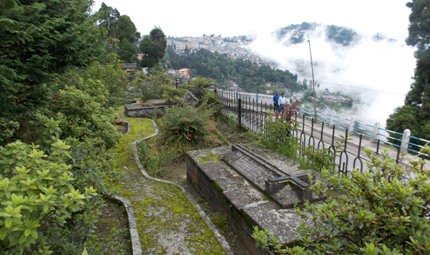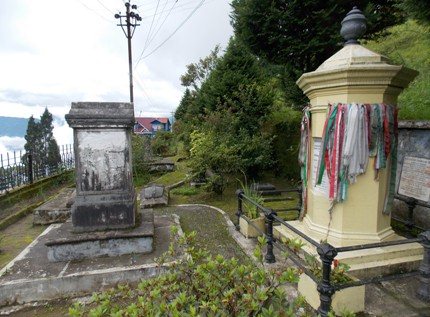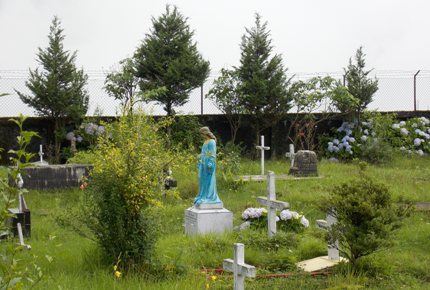Darjeeling Old Cemetery
Cemeteries often do not fall into the list of must see places when it comes to slicing out a piece of time during your vacation. But the Old Cemetery of Darjeeling which is also referred as the English Cemetery, has a definite reason to visit. This is the resting place of those early British settlers who turned the densely forested mountains here into world's most renowned tea producing estates and created this beautiful gem of a hill town. So if you take interest in recalling the British Raj memories of Darjeeling, then this is the place to go.
Old Cemetery, Darjeeling
The old cemetery is located about a mile from Darjeeling Town Center on Lebong Cart Road. There is an upper section which has a wonderful view of the tea gardens below and overlooks the Darjeeling town landscape. On a clear day, you can see the snow capped peaks of the Eastern Himalayan range including that of Kanchenjunga. In the upper section of the old cemetery, you will find graves dating back to early 1840s. So if you like to enjoy some peaceful and quiet time with great views around, this can be a great place. The lower section is close to the road.
Over the years, unfortunately the cemetery has not been maintained well enough since no organization took up that responsibility. In the earlier days many of the marbled graves had iron railings around them serving as a protective shield. No longer so. Most of them have been stolen or removed by the locals.
There are supposed to be well over 100 graves in the old cemetery. But now it's difficult to ascertain the exact number because some of the grave tombs have got destroyed over time. The inscriptions in many of the graves are now barely legible. This is probably because of the incessant pounding by the harsh monsoon weather over the centuries.
Having said that, there are some graves that are still in good condition and will surely take you back to the memories of British India days.
One such grave is that of the discoverer of Darjeeling, Lt. General George W. Aylmer Lloyd. He came here to broker a deed with the Raja of Sikkim in 1828. It was signed on February 1, 1835 granting possession of Darjeeling hills to East India Company. However Llyod loved Darjeeling and continued to stay here. He died in 1865 at the age of 76 and was buried at the old cemetery.
One of the oldest graves here is that of the great Hungarian linguist Alexander Csoma de Koros who compiled the first dictionary and grammar in Tibetan Language. He had set out to know the roots of Hungarians and went through tremendous hardships to reach Tibet, but finally mastered the Tibetan language in nine years.
Tomb of Alxendar Csoma de Koros on right
He was born in 1784 and died in Darjeeling in 1842 on his way to Lhasa. This is a hexagonal memorial tomb built on a low platform and over the grave of Alexander. Between 1837 and 1842, he served as the Librarian of Asiatic Society, Calcutta Chapter. Every year, the Hungarian government sends officials here to lay the wreath and garland the tomb. The grave is nicely fenced and decorated with beautiful flower beds around it.
One of the other graves that I like personally at the old cemetery is the one which has inscription in high Victorian style and is a beautiful tribute by a desolate husband to his departed wife. It starts with:
"To The Memory of
REBECCA
The Wife of T. BRACKEN ESQ.
OB: 27th September 1844 ....."
Another one on the lower section of the cemetery says "Like the flower of the field which to day is and tomorrow withered away. Blessed are the pure in heart as they shall see god".
Once the cemetery used to be under the Jurisdiction of St. Andrew's Church located on Mall Road. In 1970s, the church conducted a survey and photographed the inscriptions on the graves to keep a record of all who were buried here.
Das Studio was appointed to take the photographs. Mysteriously, that record is now missing. With many of the inscriptions having been wiped off, it's now virtually impossible to know the identity of many who have been buried in this cemetery.
The Archeological Survey of India (the Calcutta Chapter) had declared the Old Cemetery in Darjeeling as a site of "National Importance" and has been maintaining the two historical graves. However when it comes to the entire cemetery, it is apparent that a lot more needs to be done. In 1977 the BACSA (British Association of Cemeteries in South Asia) was formed which works through various local and overseas organizations and lends its support for preservation of the historical monuments at the old cemetery.
Being an unguarded free public area, during the high season you will often find locals having setup temporary stalls right inside the cemetery selling street snacks like momos, eggs, potato wafers, hot tea etc. And I was surprised to see that they had a good client base. Not just the tourists, but many local couples and loiterers indulge in the tea and food.
Entry
Open daily, from sunrise to sunset. Entry is free.
Location
Darjeeling Old Cemetery is located along Lebong Cart Road about a mile from the town center and right next to 'Krishna Residency' vacation rental. It's an easy walk from Chowk Bazaar area or the Chowrasta Mall. Otherwise you can always take a shared jeep from motor stand at Chowk Bazaar. While approaching the cemetery, it'll be on your right. There is no signage and the entrance is not very prominent, neither locals know the name of this cemetery, so keep a watch.
Other Cemeteries in Darjeeling
There are two other cemeteries in Darjeeling - Singtom Cemetery and Parsee Cemetery. The Singtom Cemetery is located at North Point further down on Lebong Cart Road and below St. Joseph's College. This cemetery is also known as the "New Cemetery" and was opened in the year 1858 to provide for further burial provision.
Singtom Cemetery, Darjeeling
This is a much larger cemetery than the Old Cemetery, although the approach is through a steep narrow lane from Singamari taxi stand that leads all the way down to Singtom Tea Estate. As you enter through the gate, the huge archway and the statue of Christ at the end look awesome. And on the left is the burial ground as shown in the picture above.
Related Articles
|
Visitors' Reviews/Comments
Bek Lixina (April 2019)
In such a beautiful place called Darjeeling, there lies an abandoned cemetery with no proper maintenance, broken tombs by the locals, stolen marbles, hanging place for couples sitting on the grave indulged into drinking, smoking and other obscene act. Govt. can at least hand over the entire grave to ASI, or to the church, at least an entry fee could have been initiated so that maintenance of the cemetery would have taken place. The police patrol team should also be active to keep the above things under control.
The houses nearby the grave, seems like the graves just adjacent to it will be encroach in the years to come. The care takers house lies above the top without any incentives to the family except an amount of Rs. 150 per month by the church committee .
David Price (March 2014)
I would be most grateful if you could confirm that the Happy Valley Tea estate is close to the Old English Hill Cart Road Cemetery. My reason for asking is that my Great Grandmother was buried in this cemetery in 1907. I also have a photograph looking across the Happy Valley Tea Garden towards the main part of Darjeeling. Thanking you in anticipation, Best wishes.
Raj (darjeeling-tourism.com) March 2014
Hi, Yes. Old English Hill Cart Road Cemetery (known as Old Cemetery) is close to Happy Valley Tea Estate. The Cemetery is on Lebong Cart road. In fact from the other side of the road you get sweeping view of the tea estate. A narrow approach road from Lebong Cart road leads down to the tea garden. You can see the location of the cemetery (trace Lebong Cart Road) and the Happy Valley (bottom left corner - the red strip) in this map.
|


